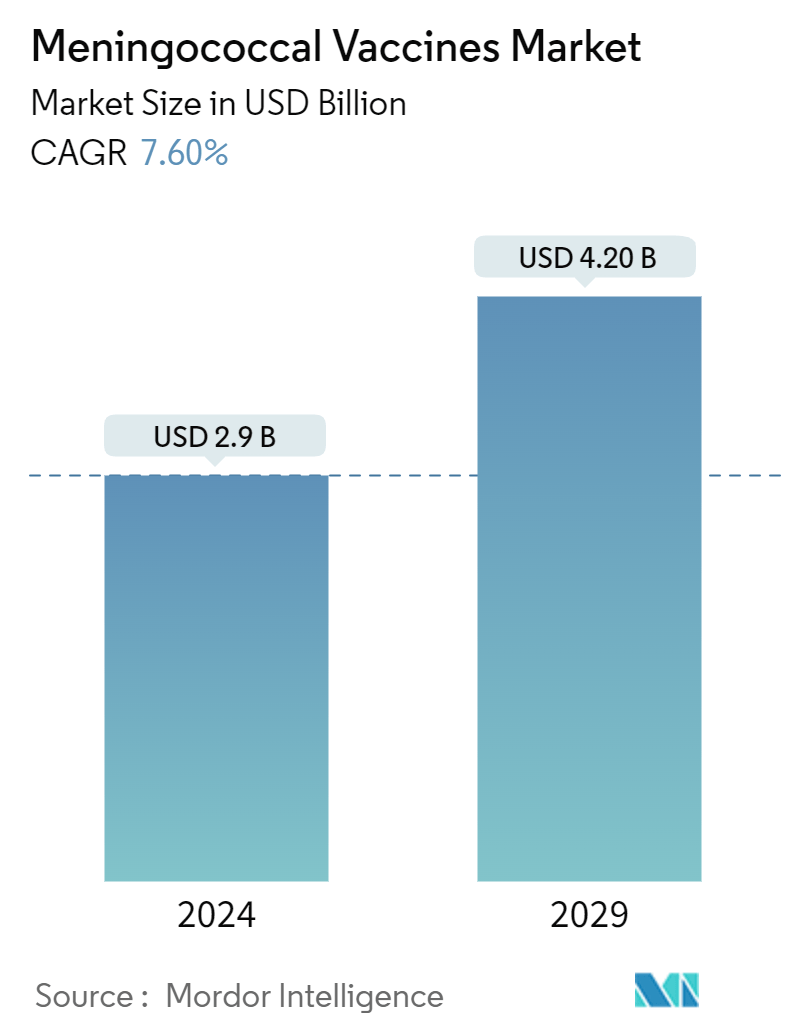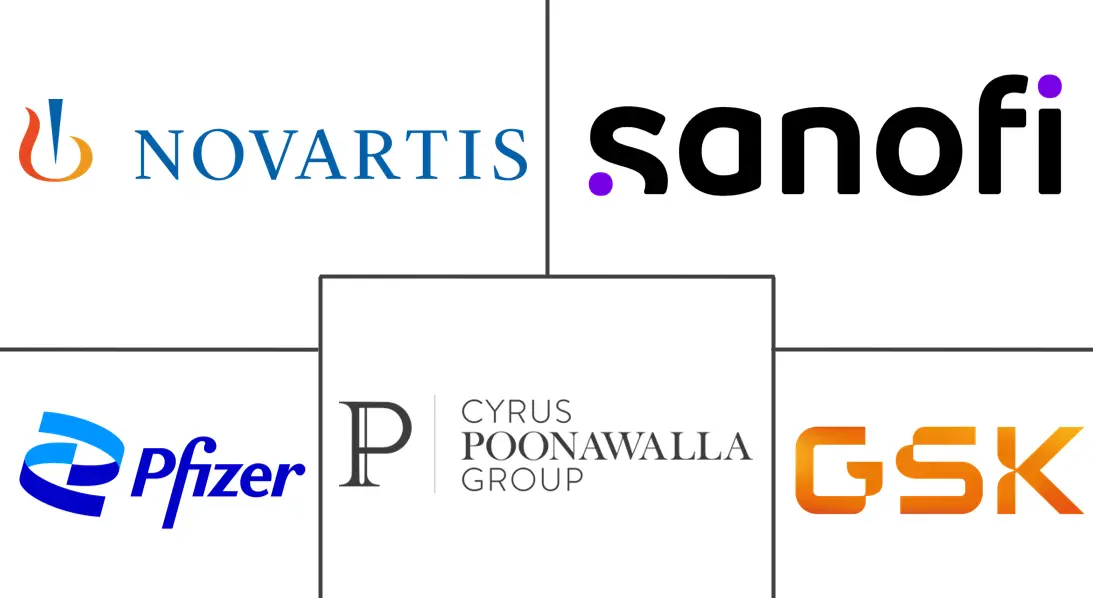Market Size of Meningococcal Vaccines Industry

| Study Period | 2019 - 2029 |
| Market Size (2024) | USD 2.9 Billion |
| Market Size (2029) | USD 4.20 Billion |
| CAGR (2024 - 2029) | 7.60 % |
| Fastest Growing Market | Asia Pacific |
| Largest Market | North America |
| Market Concentration | Medium |
Major Players
*Disclaimer: Major Players sorted in no particular order |
Meningococcal Vaccines Market Analysis
The Meningococcal Vaccines Market size is estimated at USD 2.9 billion in 2024, and is expected to reach USD 4.20 billion by 2029, growing at a CAGR of 7.60% during the forecast period (2024-2029).
- The meningococcal vaccines market plays a critical role in safeguarding public health by preventing meningococcal disease, a severe and potentially lethal infection caused by the Neisseria meningitidis bacteria. The global meningococcal vaccines market is defined by the ongoing development and distribution of vaccines that target various strains of this bacterium. These vaccines are pivotal in controlling outbreaks and protecting high-risk populations, particularly in regions with a higher incidence of the disease.
Collaborative Efforts Drive Vaccine Development
- Public-Private Partnerships: The rise of public-private partnerships has been transformative in the meningococcal vaccines market. These collaborations merge the resources and expertise of governments, NGOs, and pharmaceutical companies, enhancing vaccine development and distribution. By pooling resources, these partnerships reduce costs and expedite the availability of vaccines in underserved regions. They also play a critical role in funding R&D activities, leading to the creation of new and improved vaccine formulations, which is vital for the global meningococcal vaccine production landscape.
- Immunization Programs: Immunization programs are foundational to public health policy, driving the demand for meningococcal vaccines. Governments are adopting proactive measures to ensure widespread vaccine coverage, particularly in areas prone to outbreaks. These initiatives often include subsidies or free vaccination programs, making vaccines accessible to larger population segments. Additionally, policies focused on disease prevention are encouraging pharmaceutical companies to invest in the development of more effective and affordable vaccines, further boosting the meningococcal vaccines market growth.
Logistical Challenges in Vaccine Distribution
- High Costs of Storage and Supply: The distribution of meningococcal vaccines presents significant challenges, primarily due to the high costs associated with maintaining cold chain logistics. These vaccines must be stored at specific temperatures to remain effective, necessitating a costly infrastructure. The requirement for temperature-controlled storage and transportation increases the overall cost of vaccine delivery, posing challenges for healthcare providers, especially in low-resource settings. Despite these obstacles, efforts are ongoing to develop more stable vaccine formulations, which could reduce the dependence on cold chain logistics and enhance the meningococcal vaccine market outlook.
Meningococcal Vaccines Industry Segmentation
Meningococcal meningitis is a rare but potentially devastating bacterial infection that targets the brain. Despite growing advances in medical care, the disease can kill the host within a relatively short period. The meningococcal vaccine refers to any of the vaccines used to prevent infection by Neisseria meningitis, and various types of vaccines are available on the market.
The meningococcal vaccines market is segmented by type, end user, and geography. Based on type, the market is segmented into polysaccharide vaccines, conjugate vaccines, combination vaccines, and other types. Based on end users, the market is segmented into hospitals, pharmacy stores, and other end users. Based on geography, the market is segmented into North America, Europe, Asia-Pacific, Middle East and Africa, and South America. The report also covers the estimated market sizes and trends for 17 countries across major regions globally. The report offers the value (USD) for the above segments.
| By Type | |
| Polysaccharide Vaccines | |
| Conjugate Vaccines | |
| Combination Vaccines | |
| Other Types |
| By End User | |
| Hospitals | |
| Pharmacy Stores | |
| Other End Users |
| Geography | ||||||||
| ||||||||
| ||||||||
| ||||||||
| ||||||||
|
Meningococcal Vaccines Market Size Summary
The meningococcal vaccines market is poised for significant growth, driven by increased public awareness and educational programs highlighting the importance of vaccination. The market is benefiting from various immunization initiatives, such as the School-Based Immunization Program in Western Australia, which includes meningococcal vaccines. The development of novel vaccines, like the pentavalent meningococcal conjugate vaccine being studied in sub-Saharan Africa, is also contributing to market expansion. Public-private partnerships are playing a crucial role in supporting vaccine development and awareness campaigns, further propelling market growth. However, challenges such as the high costs associated with vaccine storage and supply may impede progress.
The United States is expected to dominate the meningococcal vaccine market due to its advanced healthcare infrastructure and heightened awareness of the disease. Despite a temporary decline in vaccination rates during the COVID-19 pandemic, efforts to contain outbreaks, such as the CDC's recommendations in Florida, have spurred demand for vaccines. The market is moderately fragmented, with key players like GlaxoSmithKline, Pfizer, and Sanofi Pasteur employing strategies such as partnerships and new product launches to maintain their market positions. These companies are actively investing in expanding their vaccine pipelines, which is anticipated to sustain the market's growth trajectory over the forecast period.
Meningococcal Vaccines Market Size - Table of Contents
-
1. MARKET DYNAMICS
-
1.1 Market Overview
-
1.2 Market Drivers
-
1.2.1 Increase in Public-Private Partnerships to Support Development of Vaccines at Low Cost
-
1.2.2 Rising Immunization Programs and Government Initiatives
-
-
1.3 Market Restraints
-
1.3.1 High Cost Associated with Storage and Supply of Vaccines
-
-
1.4 Porter's Five Forces Analysis
-
1.4.1 Threat of New Entrants
-
1.4.2 Bargaining Power of Buyers/Consumers
-
1.4.3 Bargaining Power of Suppliers
-
1.4.4 Threat of Substitute Products
-
1.4.5 Intensity of Competitive Rivalry
-
-
-
2. MARKET SEGMENTATION (Market Size - Value in USD)
-
2.1 By Type
-
2.1.1 Polysaccharide Vaccines
-
2.1.2 Conjugate Vaccines
-
2.1.3 Combination Vaccines
-
2.1.4 Other Types
-
-
2.2 By End User
-
2.2.1 Hospitals
-
2.2.2 Pharmacy Stores
-
2.2.3 Other End Users
-
-
2.3 Geography
-
2.3.1 North America
-
2.3.1.1 United States
-
2.3.1.2 Canada
-
2.3.1.3 Mexico
-
-
2.3.2 Europe
-
2.3.2.1 Germany
-
2.3.2.2 United Kingdom
-
2.3.2.3 France
-
2.3.2.4 Italy
-
2.3.2.5 Spain
-
2.3.2.6 Rest of Europe
-
-
2.3.3 Asia-Pacific
-
2.3.3.1 China
-
2.3.3.2 Japan
-
2.3.3.3 India
-
2.3.3.4 Australia
-
2.3.3.5 South Korea
-
2.3.3.6 Rest of Asia-Pacific
-
-
2.3.4 Middle East and Africa
-
2.3.4.1 GCC
-
2.3.4.2 South Africa
-
2.3.4.3 Rest of Middle East and Africa
-
-
2.3.5 South America
-
2.3.5.1 Brazil
-
2.3.5.2 Argentina
-
2.3.5.3 Rest of South America
-
-
-
Meningococcal Vaccines Market Size FAQs
How big is the Meningococcal Vaccines Market?
The Meningococcal Vaccines Market size is expected to reach USD 2.9 billion in 2024 and grow at a CAGR of 7.60% to reach USD 4.20 billion by 2029.
What is the current Meningococcal Vaccines Market size?
In 2024, the Meningococcal Vaccines Market size is expected to reach USD 2.9 billion.

